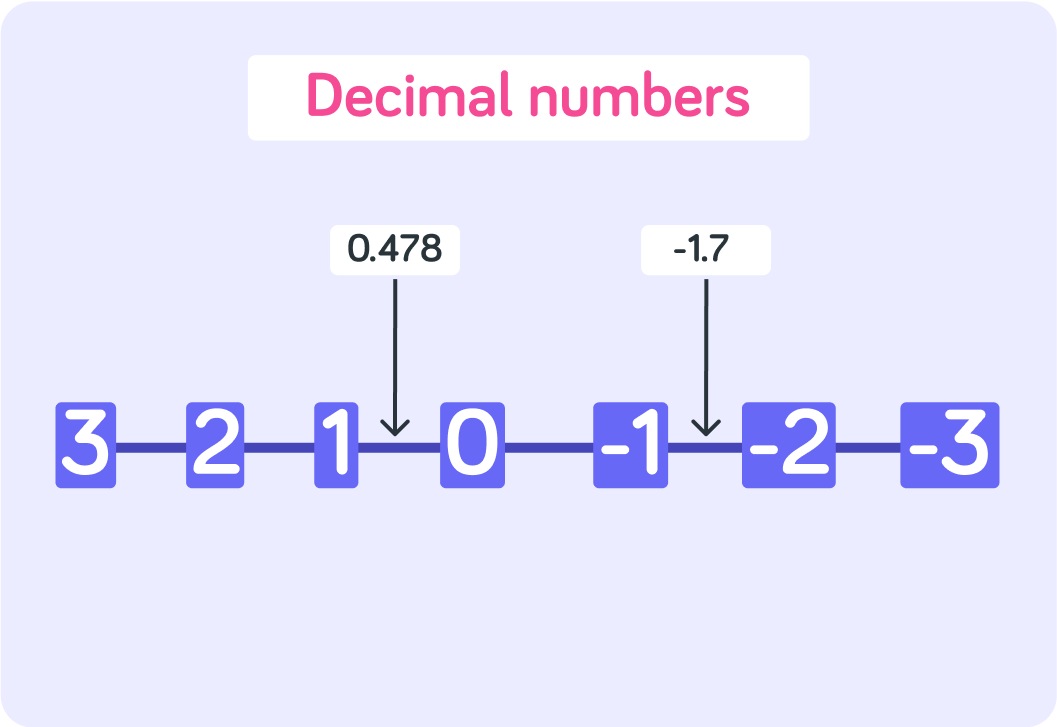YOU ARE LEARNING:
Decimals and Place Values

Decimals and Place Values
Decimals are another way to represent numbers which are not whole. They also have place values.
This is a number line
In-between the whole numbers (the integers), there are numbers slotted in that are not whole.

These numbers that are not whole numbers are called _________ numbers.


So what do you think you call the "dot" in decimal numbers?
A) Number point B) Decimal point


So decimal numbers are numbers in-between whole numbers
This lesson focuses on how much the ciphers after the decimal point are actually worth.
For example, how much is the 7 worth in 0.478?

First of all, though!
Have a look at the place values of the numbers before the decimal point.

What is the place value of the 4 in this example?
A) 1,000 B) 100 C) 10


How much is the 4 "worth" then?


What is the place value of the 7?
A) 1 B) 10 C) 100


True or false? Every time you move one place value to the left, the place value gets 100× larger.


Every time you move one place value to the left, the value gets 10× larger
Tens are 10× larger than units. Hundreds are 10× larger than tens. Thousands are 10× larger than hundreds.

Now, how about the place value of the decimals?
Decimals are the numbers after the decimal point.

True or false? The 5 in this number has place value 1,000 just like the 4?


The 5 has place value 1,0001 or "one thousandth"
The 4 on the left-hand-side of the decimal point has place value thousand, so it is worth 4,000
The 5 on the right-hand-side of the decimal point has place value thousandth, so it is only worth 0.005

Is the place value for the 1 bigger or smaller than the place value for the 5?
A) Bigger B) Smaller


What place value does the 1 have?
A) 101 B) 1001


What is the place value for the 2?


Every time you move one place value to the right, the place value gets 10× ___________.
A) larger B) smaller


So the place values are smaller than 1 on the right-hand-side of the decimal point
1 tenth is the same as 101 1 hundredth is the same as 1001 1 thousandth is the same as 1,0001

How many tenths are there in this decimal number?


How many hundredths are there in this decimal number?


How many thousandths are there in this decimal number?


So 0.472 has...
4 tenths. 47 hundredths. 472 thousandths.

How many hundredths are there in the decimal number 0.025?

How many tenths are in the decimal number 0.379?

How do you write 34 hundredths as a decimal number?

How do you write 583 thousandths as a decimal number?

Now! How do you write 23 thousandths as a decimal number?

Which one is the biggest decimal number?

Which one is the biggest decimal number?

Summary! Decimal numbers are numbers in-between whole numbers
Decimals are the numbers that follow the decimal point.

Decimals have place values
The first decimal has place value 101 (1 tenth). The second decimal has place value 1001 (1 hundredth). The third decimal has place value 1,0001 (1 thousandth).

Place values change by 10× when you move left or right
They get 10× bigger every time you move one place left. They get 10× smaller every time you move one place right.

